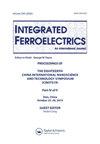温度对BCZT陶瓷疲劳性能的影响及同步x射线吸收光谱缺陷分析
IF 0.7
4区 工程技术
Q4 ENGINEERING, ELECTRICAL & ELECTRONIC
引用次数: 0
摘要
摘要本文研究了温度对锆钛酸钡钙(Ba0.85Ca0.15Zr0.1Ti0.9O3)陶瓷电疲劳性能的影响。疲劳退化及其实际应用是压电/铁电陶瓷研究中的一个重要问题。采用x射线衍射(XRD)、同步加速器x射线吸收光谱(XAS)和扫描电镜(SEM)技术研究了疲劳诱导的畴取向、物理损伤或微裂纹和缺陷。残余极化(Pr)随疲劳循环次数的增加而降低,且随疲劳温度的升高而降低的速率不同。弱域和强域壁钉钉效应对疲劳循环的Pr值起主要作用。5 × 103次循环时Ec值急剧上升,5 × 104次循环后Ec值急剧下降,这可能与现场筛选效应和固定畴的热回收有关。在5 × 105次循环后,Pr值的急剧下降可能是由于电极界面附近的物理损伤,随着疲劳温度的升高,相同的物理损伤减小。利用近边x射线吸收精细结构(NEXAFS)研究氧相关缺陷浓度。关键词:无铅陶瓷;温度相关疲劳;氧缺陷;挪威科技大学材料科学与工程系的Julia Glaum因其有益的讨论而受到认可。Suranaree理工大学陶瓷工程学院Siriporn Tigunta博士和Mongkol Kongtungmon先生对他们的技术支持表示感谢。披露声明作者未报告潜在的利益冲突。本研究由上海科技大学研究与发展基金资助。本文章由计算机程序翻译,如有差异,请以英文原文为准。
Temperature Effect on Fatigue Behavior of BCZT Ceramics and Defects Analysis by Synchrotron X-Ray Absorption Spectroscopy
AbstractThis paper presents the effect of temperature on the electrical fatigue behavior of barium calcium zirconate titanate (Ba0.85Ca0.15Zr0.1Ti0.9O3) ceramics. Fatigue degradation and its practical applications are a significant problem in piezo/ferroelectric ceramics. Fatigue-induced domain orientations, physical damage or microcracking, and defects were studied using, X-ray diffraction (XRD), synchrotron X-ray absorption spectroscopy (XAS), and scanning electron microscope (SEM) techniques. The remnant polarization (Pr) decreased with the number of fatigue cycles, and the rate at which the decrease occurred was different for different fatigue temperatures. The weak and strong domain wall pinning effects played a major role in the Pr value with respect to the fatigue cycles. The sharp rise of Ec value at 5 × 103 cycles and the abrupt decrease of Ec values after 5 × 104 cycles could be due to the field screening effect and heat recovery of pinned domains. The abrupt decrease of Pr values after 5 × 105 cycles could be due to physical damage near the electrode interface region, and the same physical damage decreased with the increase in fatigue temperature. The near-edge X-ray absorption fine structure (NEXAFS) study was utilized to evaluate the oxygen-related defect concentration.Keywords: Lead-free ceramicstemperature-dependent fatigueoxygen defectsdepolarization of domainsNEXAFS AcknowledgmentsDr. Julia Glaum, Department of Materials Science and Engineering, Norwegian University of Science and Technology, Norway, is acknowledged for her useful discussion. Dr. Siriporn Tigunta and Mr. Mongkol Kongtungmon, School of Ceramic Engineering, Suranaree University of Technology, are acknowledged for their technical support.Disclosure StatementNo potential conflict of interest was reported by the author(s).Additional informationFundingThis work is supported by the SUT Research and Development Fund.
求助全文
通过发布文献求助,成功后即可免费获取论文全文。
去求助
来源期刊

Integrated Ferroelectrics
工程技术-工程:电子与电气
CiteScore
1.40
自引率
0.00%
发文量
179
审稿时长
3 months
期刊介绍:
Integrated Ferroelectrics provides an international, interdisciplinary forum for electronic engineers and physicists as well as process and systems engineers, ceramicists, and chemists who are involved in research, design, development, manufacturing and utilization of integrated ferroelectric devices. Such devices unite ferroelectric films and semiconductor integrated circuit chips. The result is a new family of electronic devices, which combine the unique nonvolatile memory, pyroelectric, piezoelectric, photorefractive, radiation-hard, acoustic and/or dielectric properties of ferroelectric materials with the dynamic memory, logic and/or amplification properties and miniaturization and low-cost advantages of semiconductor i.c. technology.
 求助内容:
求助内容: 应助结果提醒方式:
应助结果提醒方式:


